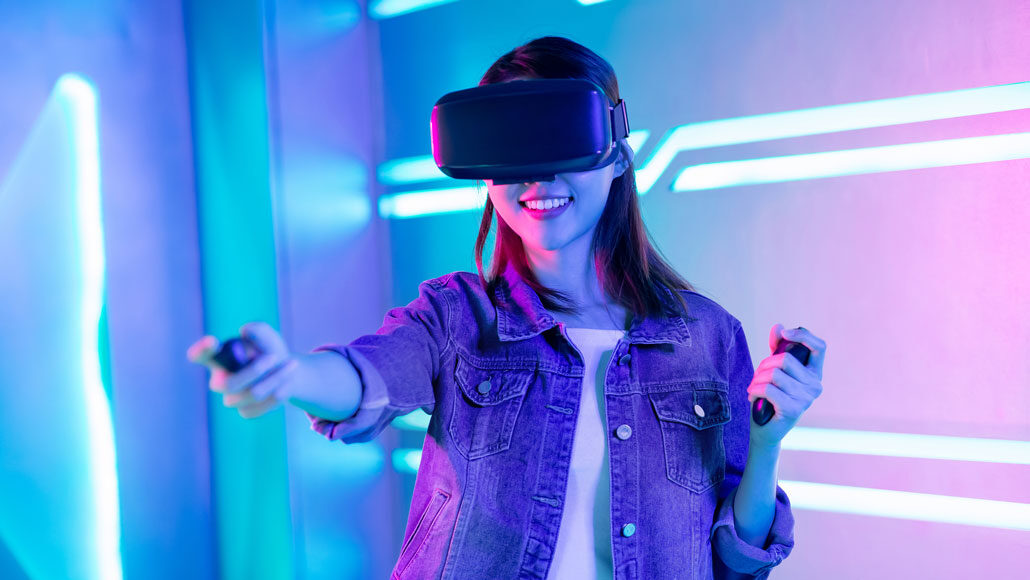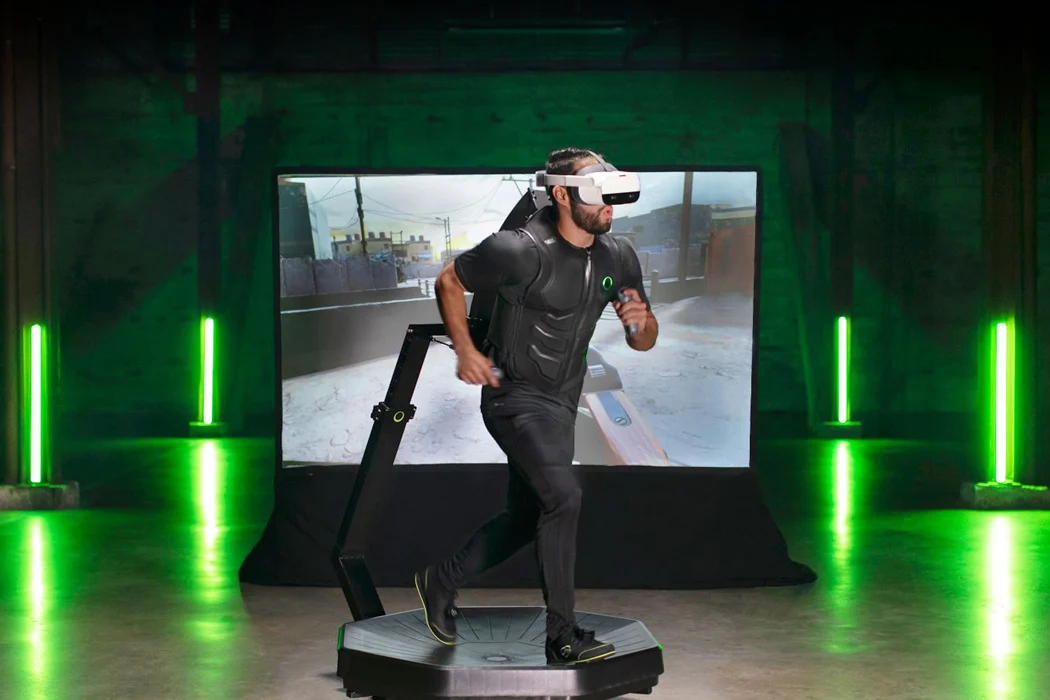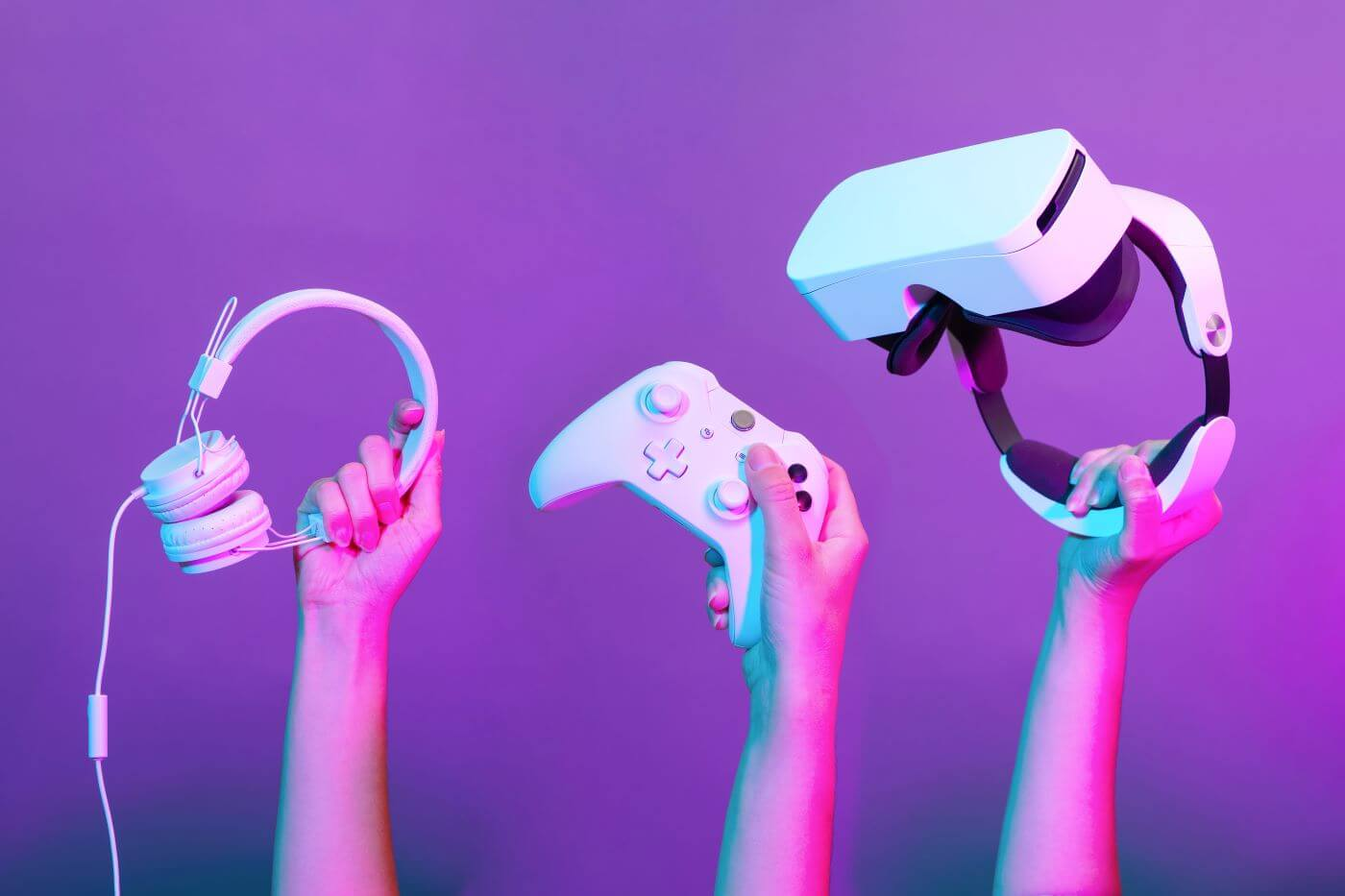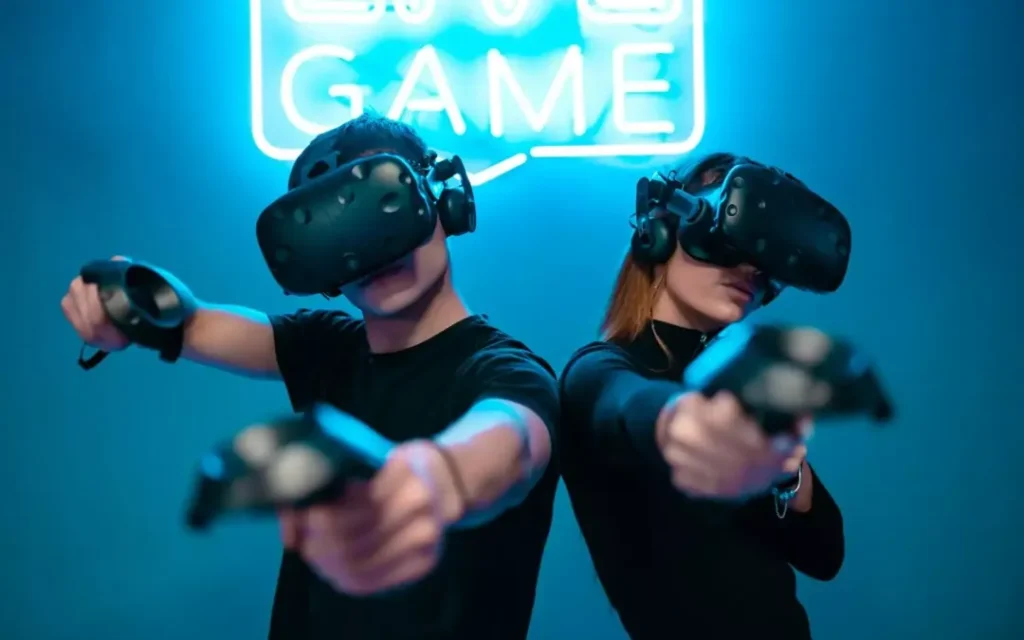In recent years, virtual reality (VR) has emerged as a groundbreaking technology with immense potential in the gaming and entertainment industries. This immersive experience allows users to step into a digital world, blurring the lines between reality and fantasy. Whether it’s exploring enchanted realms or battling aliens in outer space, virtual reality has revolutionized the way we engage with games and entertainment.
Understanding Virtual Reality

Before diving into the impact of virtual reality in gaming and entertainment, it’s essential to grasp the concept of VR. Essentially, virtual reality is an artificial environment that replicates real-world experiences using computer-generated simulations.
The Concept of Virtual Reality
Virtual reality is built upon the idea of transporting individuals to a different realm. Through the use of headsets, controllers, and sensors, users can manipulate their surroundings and interact with virtual objects. The combination of high-resolution displays, motion tracking, and realistic sound effects creates a convincing virtual experience that can transport users to unimaginable worlds.
Imagine putting on a virtual reality headset and being instantly transported to the top of a snowy mountain. You can feel the crisp, cold air on your face as you look around at the breathtaking view. You reach out your hand and can almost touch the snowflakes falling gently around you. With virtual reality, you can explore places and scenarios that would otherwise be impossible or impractical to experience in real life.
Virtual reality is not limited to visual and auditory experiences. Some advanced virtual reality systems can also incorporate haptic feedback, allowing users to feel physical sensations within the virtual environment. For example, if you were to pick up a virtual object, you would feel a sense of resistance and weight as you lift it, enhancing the sense of realism and immersion.
Evolution of Virtual Reality Technology
Over the years, virtual reality technology has come a long way. Early iterations of VR lacked the necessary computing power and display quality to deliver a truly immersive experience. However, advancements in hardware and software have paved the way for more sophisticated VR systems. Today, virtual reality headsets such as the Oculus Rift, HTC Vive, and PlayStation VR offer unprecedented levels of immersion and realism.
One of the key advancements in virtual reality technology is the improvement in display resolution. Early VR headsets had relatively low-resolution screens, which resulted in a pixelated and blurry visual experience. However, modern VR headsets now boast high-resolution displays that provide crisp and detailed visuals, enhancing the overall immersion.
In addition to display resolution, motion tracking technology has also significantly improved. Early VR systems relied on basic head tracking, which only allowed users to look around in the virtual environment. However, modern VR headsets incorporate advanced motion tracking sensors that can track the movement of the user’s head, hands, and even full-body motion. This positional tracking enables users to interact with the virtual world in a more natural and intuitive way.
Furthermore, the development of more powerful and efficient computer processors has allowed for more complex and realistic virtual environments. VR experiences can now feature detailed textures, realistic lighting effects, and lifelike physics simulations, all of which contribute to a more fully immersive experience, and believable virtual reality experience.
From improved graphics and audio quality to more intuitive and immersive interaction methods, the possibilities for virtual and augmented reality gaming are endless.
VR Gaming

Gaming has been at the forefront of virtual reality adoption since its inception. The integration of VR technology has elevated gaming experiences, enabling players to become fully engulfed in their favorite titles.
Virtual reality has revolutionized the way gamers interact with their virtual worlds. The impact of this technology on the gaming experience cannot be overstated. VR technology puts players at the center of the action, allowing them to fully immerse themselves in the game world. Gone are the days of simply controlling a character on a screen; with virtual reality, players can physically explore their surroundings, interact with objects, and engage in thrilling gameplay.
Imagine stepping from three dimensional reality into a virtual world where you can feel the wind on your face as you soar through the skies on the back of a dragon, or where you can reach out and touch the virtual objects around you. Virtual reality brings these experiences to life, blurring the line between the real and the virtual.
Impact of Virtual Environment on Gaming Experience
The impact of virtual reality on gaming experience goes beyond just visual immersion. With the use of motion controllers and haptic feedback devices, players can now feel the weight of a virtual sword in their hands or the recoil of a virtual gun. This level of sensory feedback adds a whole new dimension to gaming, making it more engaging and realistic experiences.
Moreover, virtual reality has opened up new possibilities for multiplayer gaming. Players can now connect with friends from around the world and experience virtual adventures together. Whether it’s teaming up to solve puzzles or battling against each other in intense virtual arenas, virtual reality has brought a new level of social interaction to gaming.
Popular VR Games
With the rise of virtual reality, numerous games have embraced this immersive technology. From heart-pounding horror experiences to breathtaking adventure games, there’s a wide range of virtual reality titles to suit every gamer’s preferences.
One popular virtual reality game is “Beat Saber,” a rhythm-based game where players slash through musical beats with lightsabers. As the music plays, players must use their virtual swords to slice through the beats in time with the music, creating a mesmerizing and exhilarating experience.
Another highly acclaimed virtual reality game is “Superhot VR,” a time-bending shooter where time moves only when you do. In this game, players must navigate through a series of intense combat scenarios, using their wits and reflexes to dodge bullets and eliminate enemies. The unique time manipulation mechanic adds a strategic element to the gameplay, making every move and decision crucial.
These are just a few examples of the many virtual reality games that have captivated gamers worldwide. With the continuous advancements in virtual and mixed reality technology, the future of gaming looks incredibly promising, promising even more immersive and unforgettable experiences for players.
Virtual Reality in Entertainment

Beyond gaming, virtual reality has also made significant inroads into the realm of entertainment, transforming the way we consume movies, television shows, and live performances.
Virtual reality has opened up new horizons for the film and television industry. VR movies and shows offer viewers a more immersive and interactive experience, allowing them to become part of the story. With VR headsets, audiences can step into the shoes of characters, explore their surroundings, and feel like they are right in the middle of the action.
Imagine watching a sci-fi thriller in virtual reality. As the protagonist finds themselves in a high-stakes chase, you can feel the adrenaline rush as you run alongside them, dodging obstacles and feeling the wind rush past your face. The level of engagement and excitement is unparalleled, as you are no longer a passive observer but an active participant in the narrative.
Virtual reality has also revolutionized the music industry, giving artists and fans the ability to connect on a whole new level. With virtual reality concerts, music lovers can enjoy live performances from the comfort of their homes. By strapping on a VR headset, they can find themselves front row center at a sold-out show, surrounded by fellow fans, and experiencing the energy of the performance in a truly immersive way.
Virtual reality has also opened up new possibilities for live theater performances. With VR headsets, theater enthusiasts can enjoy front-row seats to Broadway shows without leaving their homes. They can witness the emotions of the actors up close, see every intricate detail of the set design, and even explore different camera angles to enhance their viewing experience.
Getting Started with VR Gaming

Choosing the Right VR System for Your Needs
The Evolution of Virtual Reality Gaming
Virtual reality gaming has revolutionized the way we perceive interactive entertainment. No longer confined to the constraints of two-dimensional screens, gamers can now immerse themselves in intricately designed virtual environments. However, with the multitude of VR gaming systems available, selecting the right one can be daunting.
Factors to Consider When Choosing a VR System
Hardware Specifications and Processing Power
When delving into virtual reality, the processing power of your chosen VR system plays a pivotal role in delivering seamless and immersive experiences. High-end VR systems, such as the Valve Index or HTC Vive, offer advanced hardware capabilities, ensuring smooth gameplay and realistic graphics. Evaluate the specifications, including GPU requirements and refresh rates, to ascertain compatibility with your computer.
Tracking Technology and Motion Control
Another critical aspect is the tracking technology employed by the VR headset. Advanced systems feature positional tracking, enabling precise monitoring of the player’s movements within the virtual world. Coupled with intuitive motion controllers, such as those accompanying the Oculus Quest, this technology facilitates a more immersive and interactive gaming experience.
Content Library and Platform Compatibility
The availability of games and applications tailored for your chosen VR platform is paramount. Platforms like Sony PlayStation VR boast an extensive library of VR games, encompassing diverse genres and experiences. Consider your gaming preferences, whether you’re inclined towards action-packed adventures or immersive storytelling, and ensure the platform aligns with your interests.
Setting Up Your VR Equipment
Preparing Your Gaming Space
Before embarking on your virtual reality journey, it’s imperative to designate a suitable gaming space. Ensure ample room to move around, free from obstructions or potential hazards. Consider environmental factors such as lighting and ensure a comfortable setup conducive to extended VR sessions.
Calibrating Your VR System
Upon assembling your VR hardware, meticulous calibration is essential to optimize performance. Follow the manufacturer’s guidelines for headset adjustment, controller pairing, and sensor placement. Pay meticulous attention to details, such as IPD (Interpupillary Distance) settings, to ensure visual clarity and minimize discomfort during gameplay.
Sample Games and Platforms: An Overview
Exploring Genre-Spanning VR Experiences
The realm of VR gaming encompasses a diverse array of genres, each offering unique gameplay mechanics and immersive narratives. From the rhythm-based challenges of Beat Saber to the atmospheric exploration of The Elder Scrolls V: Skyrim VR, there’s a virtual world tailored to every gamer’s preferences.
Platform-Specific Exclusives and Highlights
Certain VR platforms boast exclusive titles that redefine the boundaries of virtual reality gaming. PlayStation VR enthusiasts can delve into acclaimed titles like Astro Bot Rescue Mission, showcasing innovative use of VR technology. Conversely, PC-based platforms, such as Oculus Rift and Valve Index, offer a broader spectrum of games, leveraging the expansive capabilities of high-end gaming PCs.
The Future of Virtual Reality
As virtual reality continues to evolve, the future looks incredibly promising for both gaming and entertainment. The possibilities are endless, and the advancements in technology are set to revolutionize gaming consoles and the way we experience digital content.
Upcoming Trends in Virtual Reality Gaming
Virtual reality in gaming industry is projected to witness significant growth in the coming years. With the introduction of new technologies like haptic feedback suits and full-body motion tracking, the level of immersion in VR games will reach unprecedented heights. Imagine being able to feel the impact of a punch or the recoil of a gun in a virtual world. These advancements will not only enhance the gaming experience but also blur the line between reality and the virtual realm.
Furthermore, multiplayer VR experiences will become more prevalent, allowing friends and strangers alike to come together in virtual worlds. Imagine teaming up with players from different parts of the world to embark on epic quests or engage in intense battles. The social aspect of gaming will be taken to a whole new level, as players interact with each other in real-time, sharing experiences and creating lasting memories.
Innovations in Virtual Reality Entertainment
Beyond gaming, virtual reality will continue to reshape the entertainment landscape. Innovations such as virtual reality theme parks and interactive museum exhibits are just the tip of the iceberg. With VR technology, you can step into a virtual theme park and experience thrilling rides and attractions without leaving your home. The possibilities for entertainment are limitless.
As VR technology becomes more accessible and affordable, we can expect to see a wide range of creative and immersive experiences in fields such as sports, tourism, and education. Imagine attending a live sports event from the comfort of your own home, feeling the excitement and energy as if you were sitting in the stadium. Or exploring famous landmarks and historical sites from around the world, all without leaving your living room. Virtual reality has the potential to transport us to places we’ve only dreamed of, opening up a whole new world of possibilities.
Moreover, virtual reality will revolutionize education by providing immersive and interactive learning experiences. Students will be able to explore virtual environments, conduct experiments, and engage with educational content in ways that were previously unimaginable. This technology platform has the power to make learning more engaging and accessible to students of all ages and backgrounds.
The future of virtual reality is bright and full of exciting possibilities. Whether it’s through immersive gaming experiences or innovative entertainment offerings, virtual reality is set to transform the way we interact with digital content. The only limit is our imagination, and as technology continues to advance, we can expect virtual and augmented reality to become an integral part of our everyday lives.
Challenges and Opportunities in Virtual Reality
While virtual reality has tremendous potential, it also faces a unique set of challenges and opportunities.
Technical Challenges in Virtual Reality Development
Creating a seamless virtual reality experience requires overcoming various technical challenges. The need for powerful hardware, reducing motion sickness, and improving resolution are among the top priorities for VR developers. As technology continues to advance, these challenges will gradually be addressed, paving the way for more refined and accessible virtual reality experiences.
Opportunities for Growth in the Virtual Reality Market
The virtual reality market is ripe with opportunities for growth. According to industry reports, the global virtual gaming applications and reality market is expected to reach multi-billion-dollar figures in the coming years. This growth is fueled by increased consumer demand, advancements in technology, and the expanding reach of virtual reality across industries. With virtual reality becoming more mainstream, companies have a chance to capitalize on this trend by developing innovative experiences and applications.
In conclusion, virtual reality has revolutionized the gaming and entertainment industries. By providing immersive experiences and blurring the boundaries between reality and the digital realm, VR technology has forever changed the way we engage with games, movies, music, and more. As virtual reality continues to evolve, we can expect even more awe-inspiring experiences and groundbreaking applications to emerge, further solidifying its place in our everyday lives.







